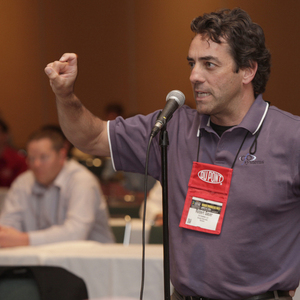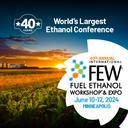Producers presented with options for coproduct diversification

Rich Clark Photography
June 11, 2014
BY Ron Kotrba
Diversifying ethanol coproduct streams is big business in today’s market as producers seek to add value to their product portfolios, a major focus of discussion at the 2014 International Fuel Ethanol Workshop & Expo in Indianapolis this week.
With the popularity of corn oil extraction at ethanol plants, the average fat content of DDGS has dropped to 6.6 percent in North America, according to Harold Tilstra, manager of technical support for DDGS marketing at Purina Animal Nutrition LLC. This information was gleaned from 69 sources recently sampled.
“The primary cost of feeding animals is energy,” Tilstra said, adding that removing oil from DDGS lowers total gross calories. Tilstra reminded the audience that the end user of DDGS is not the livestock farmer but rather the nutritionist who provides inclusion rates to the farmer. “Know your buyer and who you’re selling to,” Tilstra said.
Value, according to Tilstra, can be added to DDGS in one of two ways: Making better use of the nutrients that are there (an information management issue); and making the nutrients that are already there more available (a process management issue).
Advertisement
Dryer management is a big opportunity for ethanol producers to increase value of DDGS, as color is an indicator of value, Tilstra said. He added that DDGS particle sizes have a wide range—300 to 1,200 microns. The larger particles can become unmixed in the feed and end up costing ethanol producers customers.
“DDGS is not ideal for any animal,” said Scott Kohl, technology director with ICM Inc. “It’s just what we have.” Kohl discussed ICM’s new Fiber Separation Technology, a low-RPM (1-4) wet fractionation process that produces high-fiber meal, high-protein meal and syrup. Kohl said the FST not only diversifies the coproduct stream and tailors feed for the various livestock markets, but it also increases oil recovery by 35 percent, provides 10 percent more fermentor space (since fiber is removed) and drops pressure across the heat exchanger by nearly half.
While ICM is offering the wet-frac option of FST, Cereal Process Technologies’ Pete Moss focused on product diversification and Renewable Identification Number, or RIN generation, through dry fractionation. He said biodiesel and ethanol integration is a natural fit but is limited by the amount of oil backend technologies can secure alone. CPT’s MarketFlex technology can obtain three times the oil from corn than conventional backend extraction. From the 2 pounds of oil per bushel available in corn, Moss said the combination of frontend and backend extraction with MarketFlex allows ethanol producers to capture 1.5 to 1.7 pounds per bushel.
Advertisement
A consistent supply of feedstock has been an obstacle for the biodiesel industry and individual companies, something MarketFlex overcomes, Moss said. Certification for kosher glycerin is also achievable, allowing higher market values for the biodiesel coproduct.
Jennifer Aurandt, technology development program manager with Valicor Inc., told FEW attendees about Valicor’s VFrac system to offer high-protein meal from stillage. VFrac is a whole stillage fractionation platform, she said, which recovers 1.1 pounds per bushel of corn oil in addition to high-fiber DDGS and high-protein meal (VPro). She said VFrac can deliver products that nutritionists value, with better handling characteristics because the solids do not contain solubles, and glycerin is excluded from the final product so it has superior flowability. Aurandt said VFrac solids contain 10 times more yeast cells than thin stillage solids. Yeast as a component of DDGS is one aspect of the feed that is rarely discussed, according to Peter Williams with Associated British Agriculture. Williams said 7 to 10 percent of the total volume of DDGS is brewer’s yeast from the fermentation process.
While several companies are focused on technologies to dissect conventional DDGS into multiple, higher-value products, Meridian Biotech’s chief technology officer Dennis Evers promoted the Meridian process of using syrup as a substrate to grow single-cell protein for aquaculture and piglet feed. The process uses a mix of anaerobic digestion, aerobic treatment and bio-augmentation that requires no design changes to an ethanol plant. The feed is 60 to 70 percent protein, Evers said.
In the end, ethanol producers have a wealth of available options to diversify their coproduct and revenue streams.
Related Stories
Ethanol Producer Magazine has announced the keynote speakers for the 2025 International Fuel Ethanol Workshop & Expo (FEW) being held June 9-11, 2025, at the CHI Health Center in Omaha, Nebraska. The general session will take place June 10.
Argent Energy, a leading European biofuels manufacturer, has officially launched Europe’s largest facility dedicated to producing biobased, technical-grade glycerin at its Port of Amsterdam site in the Netherlands.
Preliminary agenda released for 40th annual International Fuel Ethanol Workshop & Expo
Ethanol Producer Magazine announced this week the preliminary agenda for the 2024 International Fuel Ethanol Workshop & Expo (FEW) taking place June 10-12, 2024 at the Minneapolis Convention Center in Minneapolis, Minnesota.
A University of Alberta researcher has developed better ways to convert carbon dioxide, a harmful greenhouse gas, and glycerol, a leftover of biodiesel production, into value-added materials with wide-ranging uses including liquid hydrogen storage.
A group of some of the largest shrimp producers in Ecuador recently attended the Distillers Grains Technology Council's Distillers Symposium in Iowa with the USGC. The event provided an overview of the U.S. distillers’ industry.
Upcoming Events










